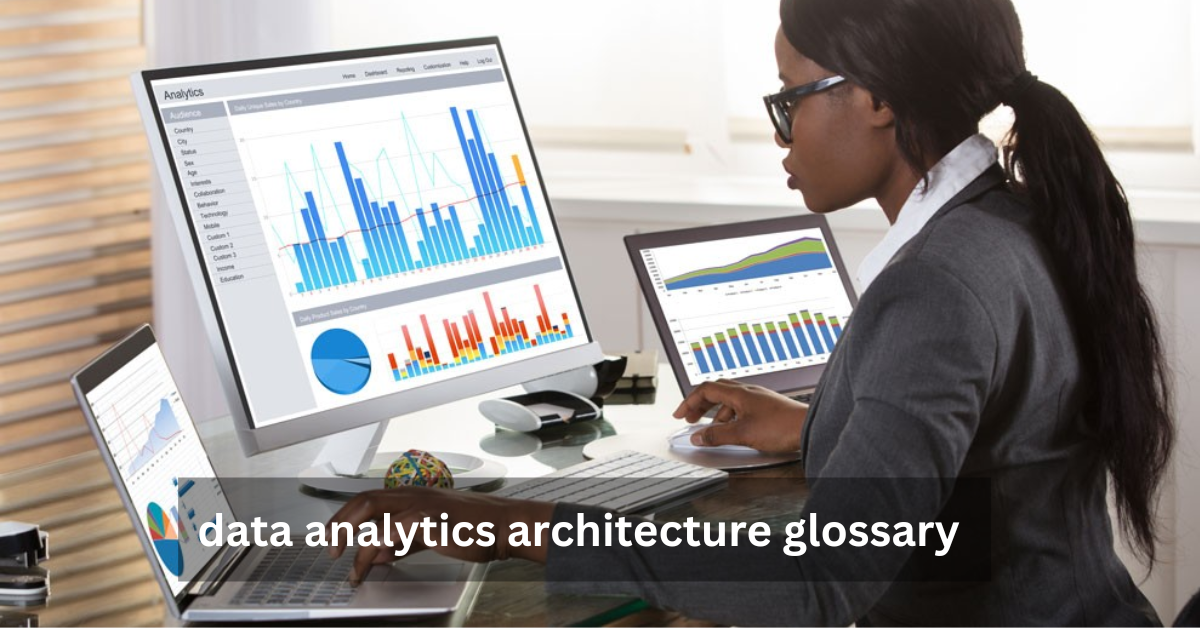In today’s data-driven landscape, organizations increasingly rely on robust data analytics architecture to navigate the complexities of vast data streams. The data analytics architecture glossary serves as a vital resource, enabling professionals from various backgrounds—be it data scientists, business analysts, or IT specialists—to effectively communicate and comprehend the intricate terminologies that define this field. This article delves into the essential components, key terms, best practices, and future trends of data analytics architecture, ensuring you are well-equipped to thrive in the realm of data-driven decision-making.
Grasping the terminology associated with data architecture is crucial. Not only does it foster clear communication among team members, but it also enhances the efficiency of projects by establishing a common language. By familiarizing yourself with the data analytics framework, you empower yourself to engage with technologies and methodologies that can significantly impact your organization’s success.
What is Data Analytics Architecture?
Definition and Key Concepts
Data analytics architecture refers to the structured framework through which data is collected, stored, processed, and analyzed. This architecture encompasses various technologies, processes, and methodologies, including big data analytics, data governance, and data visualization techniques. Understanding these foundational elements is essential for anyone involved in data analytics, as they dictate how organizations can leverage their data assets effectively.
Role in Modern Organizations
In modern organizations, data analytics architecture plays a pivotal role in driving insights and strategic decisions. By enabling seamless integration of disparate data sources and providing robust processing capabilities, businesses can uncover trends, optimize operations, and enhance customer experiences. As data continues to proliferate, the importance of a solid data analytics architecture will only grow.
Key Components of Data Analytics Architecture
Data Sources
Types of Data Sources
At the heart of data analytics lies the concept of data sources. These include internal sources such as databases and CRM systems, as well as external sources like social media feeds and market research data. Understanding the types of data sources available enables organizations to gather comprehensive insights.
Importance in Data Analytics
Data sources are the raw materials that feed into the analytics process. A diverse range of sources allows for a more holistic view of the organization’s performance and market position, ultimately leading to more informed decision-making.
Data Ingestion
Processes Involved
Data ingestion is the process of importing data from various sources into a centralized system for analysis. This can involve batch processing, where data is collected at intervals, or real-time ingestion, where data is processed as it is generated. Effective data ingestion ensures that timely and relevant data is available for analysis.
Tools for Data Ingestion
Several tools facilitate data ingestion, including Apache NiFi and Talend. These tools help automate the process, ensuring that data flows smoothly from sources to storage solutions without manual intervention.
Data Storage Solutions
Data Warehousing
Data warehousing involves storing processed and structured data in a centralized repository, optimized for querying and analysis. Solutions like Amazon Redshift and Google BigQuery provide organizations with the capability to perform complex queries efficiently, making them essential for business intelligence initiatives.
Data Lakes
In contrast, a data lake is designed to hold vast amounts of raw, unstructured data. It allows for flexibility in storage, accommodating a variety of data types, including images, videos, and JSON files. This is ideal for organizations looking to perform deep analyses without rigid schema requirements.
Data Marts
A data mart is a subset of a data warehouse focused on specific business lines or departments. By isolating relevant data, organizations can facilitate more targeted analyses, improving decision-making processes in specialized areas.
Data Processing Techniques
ETL (Extract, Transform, Load)
The ETL process is fundamental in data analytics architecture. It involves extracting data from various sources, transforming it into a usable format, and loading it into a storage system. This process ensures that data is consistent, reliable, and ready for analysis, forming the backbone of effective data management.
Real-time Processing vs. Batch Processing
Data processing can occur in real-time or in batches. Real-time data processing is crucial for industries that require immediate insights, such as finance and e-commerce. In contrast, batch processing is useful for periodic reports and analyses that do not require instant data availability.
Data Visualization
Importance of Data Visualization
Effective data visualization is key to making sense of complex data sets. By presenting data in graphical formats—such as charts and dashboards—organizations can quickly identify trends and patterns that inform decision-making.
Tools and Techniques
Tools like Tableau and Microsoft Power BI are widely used for data visualization, allowing users to create interactive dashboards that facilitate exploration of data. Mastery of these tools can significantly enhance an organization’s analytical capabilities.
Essential Terms in the Data Analytics Architecture Glossary
Big Data
Big Data refers to datasets that are so large or complex that traditional data processing applications cannot handle them. This concept encompasses the three Vs: volume, velocity, and variety. Understanding big data is crucial for leveraging its potential in analytics.
Business Intelligence (BI)
Business Intelligence (BI) encompasses the strategies and technologies used by organizations for data analysis of business information. A solid understanding of BI tools and methodologies is vital for transforming raw data into actionable insights.
Data Pipeline
A data pipeline is an automated process that moves data from one system to another, facilitating the smooth flow of data through various stages—from ingestion to processing to storage. Efficient data pipelines are essential for maintaining operational efficiency in data analytics.
Machine Learning
Machine learning is a subset of artificial intelligence that focuses on building systems that learn from and make decisions based on data. In analytics architecture, machine learning algorithms can automate data processing tasks and derive predictive insights.
Data Governance
Data governance involves the management of data availability, usability, integrity, and security. It is crucial for ensuring that data is handled responsibly and complies with regulations like GDPR and CCPA.
Data Quality and Integrity
Ensuring data quality and integrity is paramount in analytics architecture. High-quality data is accurate, consistent, and timely, allowing for reliable analyses and informed decision-making.
Predictive Analytics
Predictive analytics involves using historical data and statistical algorithms to predict future outcomes. This area is increasingly vital for businesses seeking to anticipate trends and customer behavior.
Best Practices in Data Analytics Architecture
Data Governance and Security
Implementing robust data governance frameworks is essential for maintaining data security and compliance with regulations. Organizations should establish clear policies regarding data access, usage, and sharing to protect sensitive information.
Scalability and Flexibility
A scalable and flexible architecture is vital for accommodating growing data volumes. Cloud-based analytics solutions often provide the best options for scalability, allowing organizations to adjust their resources according to demand.
Selecting the Right Tools and Technologies
Choosing the appropriate tools for data storage, processing, and analysis is critical. Organizations should evaluate their specific needs and opt for solutions that align with their objectives—whether they require data warehousing, data lakes, or machine learning platforms.
Challenges in Data Analytics Architecture
Common Issues and Solutions
Organizations often face challenges in data integration, quality, and security. Implementing best practices in data governance and investing in high-quality data processing tools can mitigate these issues, ensuring smooth operations.
Importance of Data Quality and Integration
Data quality and integration are crucial for successful analytics outcomes. Poor-quality data can lead to erroneous conclusions, making it imperative for organizations to prioritize data quality management and integration efforts.
Real-World Applications of Data Analytics Architecture
Case Studies of Successful Implementations
Many organizations have successfully implemented data analytics architecture to drive decision-making and operational efficiency. For example, leading retail companies leverage big data analytics to optimize inventory management and enhance customer experiences.
Industry-Specific Use Cases
Different industries utilize data analytics architecture in unique ways. For instance, in healthcare, predictive analytics helps identify potential health risks, while in finance, real-time data processing enables immediate fraud detection.
Future Trends in Data Analytics Architecture
Evolving Technologies and Methodologies
The landscape of data analytics is continually evolving, with emerging technologies such as Apache Spark and Snowflake offering innovative solutions for data processing and analysis. Organizations must stay abreast of these developments to maintain a competitive edge.
Impact of Artificial Intelligence and Machine Learning
The integration of artificial intelligence and machine learning into data analytics architecture is set to revolutionize the field. These technologies enhance automation and enable organizations to derive deeper insights from their data, paving the way for smarter decision-making.
Conclusion
Understanding the data analytics architecture glossary is essential for professionals in the field. From data sources to processing techniques, each component plays a vital role in enabling organizations to harness the power of their data.
By familiarizing yourself with the key terms and concepts outlined in this article, you will be better positioned to engage in data-driven initiatives within your organization. Embrace the complexity of data analytics architecture, and you will unlock the potential for transformative insights.
Frequently Asked Questions
How do data lakes differ from data warehouses?
Data lakes store raw, unstructured data, while data warehouses
store structured data optimized for querying and analysis, making them suitable for different types of analytics needs.
What are the benefits of using ETL in data analytics?
ETL (Extract, Transform, Load) processes allow organizations to integrate data from multiple sources, ensuring that it is clean, consistent, and ready for analysis, which enhances data quality and reliability.
Why is data visualization important?
Data visualization helps to simplify complex data sets, enabling users to quickly identify trends and patterns, which facilitates more informed decision-making.
What challenges do organizations face when implementing data analytics architecture?
Common challenges include ensuring data quality, integrating diverse data sources, and maintaining security and compliance. Addressing these issues requires a robust governance framework and effective tools.
How is machine learning applied within data analytics architecture?
Machine learning algorithms analyze historical data to make predictions or automate decision-making processes, enhancing the overall analytics capabilities of an organization.
What future trends should organizations watch in data analytics architecture?
Key trends include the rise of AI and machine learning technologies, the increasing use of cloud-based solutions for scalability, and the growing importance of data privacy and governance.
How can organizations ensure data quality?
Organizations can ensure data quality by implementing comprehensive data governance policies, regularly auditing data sources, and employing advanced data cleaning techniques.
What are the primary tools used for data visualization?
Some popular tools for data visualization include Tableau, Microsoft Power BI, QlikView, and Google Data Studio, each offering unique features to help users create interactive and insightful dashboards.
What is the significance of predictive analytics in business?
Predictive analytics provides organizations with foresight by identifying potential future outcomes based on historical data, thus allowing for proactive decision-making and strategic planning.
Stay in touch to get more updates & alerts on TGTube! Thank you



